Game Animals
Non-game Animals
Habitat
Songbirds & Other Birds
- A diversity of native plants, shrubs, and trees provide food, cover, and nesting sites
- Water is an important component of a backyard bird habitat
- Birds eat insects, seeds, fruits, and nectar
- Artificial feeders must be regularly cleaned to prevent spreading diseases
Species Description: Songbirds
Songbirds are found in almost every habitat in the United States. They live mainly in terrestrial habitats but also in vegetated wetlands and on shores. Orioles, finches, mockingbirds and warblers are among the hundreds of birds that make up this diverse group.
Songbirds’ diets are just as varied as their habitats. They eat seeds, berries, nectar, fruit and insects. They benefit farmers and foresters by consuming millions of insects that could damage crops and trees. Millions of homeowners and gardeners also appreciate this benefit as well. Many people create songbird habitats with native plants, water sources and nesting boxes to attract songbirds to their landscapes. Some songbirds will consume about 300 insects a day.
Forest reduction, changes in agricultural land management, and a reduction in native prairies have caused declines in many songbird species’ populations. A lack of wintering grounds is also threatening these beneficial birds. During the winter months, many species migrate to South America where their habitats are declining.
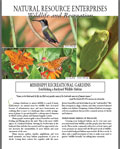
Mississippi Recreational Gardens: Establishing a Backyard Wildlife Habitat (PDF)
Mississippi State University Extension Service, Natural Resource Enterprises Program
All wildlife requires food, water and shelter to survive. This publication discusses providing those necessities in a backyard environment. Detailed information is given on how to attract birds, hummingbirds, butterflies, bats, snakes, lizards, toads and frogs. Information is also provided on controlling deer, rodents, and other animals that are considered pests. Management tips are given for making your backyard the best habitat possible including an example and how to create a trail.
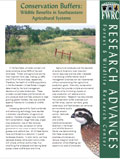
Conservation Buffers: Wildlife Benefits in Southeastern Agriculture Systems (PDF)
Mississippi State University Forest and Wildlife Research Center
Conservation buffers include filter strips, riparian buffers, grass waterways, and field borders. These practices used in conjunction with land management for timber and agriculture can enhance wildlife habitat, provide erosion control, and reduce herbicide runoff. This publication discusses the different types of conservation buffers, the environmental benefits, and the economic benefit to farmers.
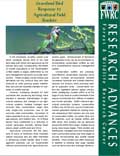
Grassland Bird Response to Agriculture Field Borders (PDF)
Mississippi State University Forest and Wildlife Research Center
Research performed at Mississippi State University the use of agricultural field border management practices and the impact on grassland bird species. "Within intensive agricultural landscapes, field borders provide important idle herbaceous cover for grassland and early successional birds. Field borders may provide nesting, foraging, roosting, loafing, and escape cover. During winter, field borders may provide important habitat in southern agricultural systems where most short distance migrants overwinter. Field borders provide important habitat for many grassland birds due to their greater abundance of food (weed seeds) and more complex vegetation structure compared to non-bordered field margins.
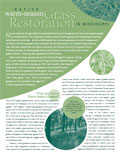
Native Warm-Season Grass Restoration in Mississippi (PDF)
Mississippi State University Forest and Wildlife Research Center
This publication defines native warm season grasses, lists examples of the types of warm season grasses and provides labeled drawings of the types. It describes the benefits of restoring native grasses and how to do so. Information is provided on keeping different non-native grass species under control. Information is also given on choosing and planting grass species in a way that restores ecosystems and is advantageous to wildlife or creates livestock forage. Use of periodic disturbances is also covered along with contact information for organizations that assist with management of warm season grasses.
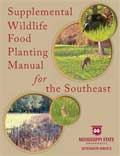
Supplemental Wildlife Food Planting Manual for the Southeast (PDF)
Mississippi State University Extension Service
This guide provides information on food plots and habitat management practices including disking, mowing and prescribed burning. The importance of openings is also discussed. A combination of supplemental forages in food planting is often necessary, as well as testing soil quality, fertilizing and liming. The location, size and shape of food plots as well as how to prepare them and which plants to use is included. An extensive guide on planting materials is given.
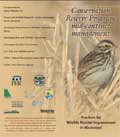
Conservation Reserve Program Mid-Contract Management: Practices for Wildlife Habitat Improvement in Mississippi (PDF)
Mississippi State University and Cooperators
Those enrolled in the Conservation Reserve Program can participate in mid-contract management activities to improve wildlife habitat that are cost-shared. In grasslands, these practices include prescribed fire, light strip-disking, interseeding legumes in introduced grass stands, and herbicidal control of invasive vegetation. In forests, these practices include prescribed fire or light disking, herbicidal control of invasive woody vegetation in pine stands, and herbicidal control of invasive exotic vegetation in pine and hardwood stands. This publication covers management techniques that are cost-shared through CRP in detail.
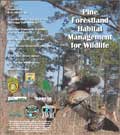
Pine Forestland Habitat Management for Wildlife (PDF)
Mississippi State University Forest and Wildlife Research Center
Pine forests can be managed to provide wildlife habitat using a variety of techniques, some of which can improve timber stand quality. Established stands can be managed with thinning, prescribed fire or disking, and even herbicide control of hardwoods which can provide food and cover for quail and grassland species, deer, rabbits, turkey and other wildlife. Regenerating stands can be managed to provide weeds, legumes, and grasses that benefit quail and other early successional wildlife species. Even former agricultural fields can be managed for grassland habitat in conjunction with pine production to include wildlife habitat.
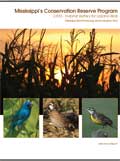
Mississippi's Conservation Reserve Program (PDF)
Mississippi State University, Natural Resources Conservation Service, Mississippi Department of Wildlife, Fisheries and Parks, USDA Farm Service Agency, Forest and Wildlife Research Center
CP33 field borders or habitat buffers are designed to benefit quail and other grassland bird populations. A research program was initiated in 2006 to study the effects of CP33 native grass habitat buffers on bird populations in Mississippi. The results of this study are presented in this report.
Conservation Buffers (PDF)
Wildlife Trends, Volume 5, Issue 2
Private landowners can improve wildlife habitat and provide other environmental benefits through practices such as conservation buffers that are easily integrated with production agriculture. Field borders may also benefit the farmer economically by taking low-yielding field margins and enrolling them in cost-share programs. This article discusses the many types of conservation buffers and the benefits that each type can provide. In addition, it provides information on the conservation programs that can provide assistance with the installation of field borders.
Small Woodlots: Important Rest Stops for Migratory Songbirds (PDF)
Purdue University
Migratory birds travel thousands of miles each year. They usually break up the trip into several segments, thus habitat for stopovers is important. Loss of forest habitat has impacted the survival of migratory songbirds. Small forest patches are important in improving the survival of migratory birds by ensuring they are healthy when they arrive to wintering or breeding grounds.
Helping Birds at Home - Improving Bird Habitat in Your Yard (PDF)
PRBO Conservation Science
Songbird populations have dwindles due to loss of habitat and the spread of exotic non-native species. Improving bird habitat in your yard can help provide valuable breeding habitat and food for resident and migratory birds. Using native plants to create structural diversity that mimic natural formations provides nesting sites. Making your yard less attractive to songbird predators is another important step. Taking care when you mow to leave no-mow areas and native tree saplings and shrubs help ground-nesting birds.
Landscaping to Create Backyard Bird Habitat (PDF)
Rutgers NJAES Cooperative Extension
Making sure your backyard includes the basic needs of wildlife can create backyard habitat for birds. Food, water, cover, and space are important. Steps to landscape your backyard for bird habitat are outlined. A description of the types of plants to consider when creating bird habitat is provided as well as a table of different species and their growing conditions and uses by wildlife.
See the Bluff Lake Rookery during nesting season up close and personal. Wading birds such as little blue herons, great egrets, scarlet ibises, cattle egrets, and more nest in this rookery in the productive wetland of Bluff Lake.
Poke salad is a tall native plant that grows in disturbed areas like old fields and produces berries that cardinals, mourning doves, bluebirds, king birds, and other birds eat.
Partridge pea is an annual plant that is native to Mississippi and attracts birds, butterfly, and rabbits. It is an excellent wildlife plant, especially for bobwhite quail.

